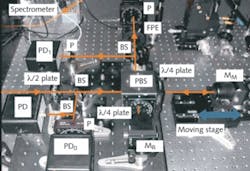Under the right environmental conditions, optical interferometers can measure macroscopic distances to nanometer accuracies. As a result, they are used for precision applications from semiconductor-wafer manufacturing to LIGO (the Laser Interferometer Gravitational-Wave Observatory; Hanford, WA, and Livingston, LA). But standard distance-measuring interferometers (DMIs) have a disadvantage: they can only measure relative–not absolute–distances. This limitation means that to measure any distance at all, an interferometer mirror must be moved along the entire distance while fringes are counted.
One way around this procedure is to exploit the output of a femtosecond pulsed laser, which consists of many monochromatic modes phase-locked in the optical-frequency domain; for example, an approach based on synthetic-wavelength interferometry (SWI) was capable of measuring absolute distances in a special tunnel of up to 240 m at a 50 µm resolution.1 But is there a way to achieve nanometer-scale resolution while simultaneously measuring long (meter- or kilometer-scale) absolute distances?
Researchers at the Delft University of Technology (Delft, The Netherlands) and Korea Advanced Institute of Science and Technology (Daejeon, South Korea) have found a way.2 They combine three distance-measuring techniques in one instrument: spectrally resolved interferometry (SRI) to reach nanometer-scale resolution, but with a nonambiguity range of about 1.5 mm; time of flight (TOF), which measures arbitrarily long absolute distances with a resolution of about 7.5 mm; and SWI, which has a resolution of about 0.16 mm and a nonambiguity range of greater than 7.5 mm. In this way, SWI links the high resolution of SRI to the absolute measuring capability of TOF.
Optical comb
The near-IR laser produces femtosecond pulses at a 75 MHz rate, which in the frequency domain is seen as an optical comb with 75 MHz spacing between the harmonics. Because the comb modes have a linewidth of less than 10 Hz, the temporal coherence length is 1.5 × 107 m; however, because the setup’s spectrometer cannot resolve these modes, the mode density has to be reduced with a Fabry-Perot etalon (FPE) filter. The result, with a 2-mm-thick FPE, is a nonambiguity range for SRI of 1.46 mm and a potential resolution of 7 nm.
For the SWI portion, synthetic wavelengths are created from the 75 MHz mode spacing and from a higher harmonic, with the results combined (cascaded) to achieve the resolution of the higher harmonic (the shorter synthetic wavelength). Finally, the TOF portion is used to determine the number of synthetic wavelengths in the path length.
The setup’s SRI and SWI were tested in the lab over the relatively short distance of 100 mm, which was the range of the lab’s motorized stage; the TOF was tested separately over a 1.11 m distance using an oscilloscope for the readout. The accuracy of the interferometric setup depends on the stability of the FPE; because the lab setup was relatively primitive, with a solid fused-silica FPE sitting out in the open under uncontrolled environmental conditions, the interferometer’s accuracy did not approach the 7 nm resolution. (The researchers compared the experiment’s measurements to those from a standard DMI; discrepancies of up to 0.9 µm were attributed to environmental conditions and a cosine error.) But the experiment demonstrated that SRI, SWI, and TOF have the right characteristics to operate together unambiguously–creating the potential for a “point-and-shoot” DMI that could quickly measure distances up to kilometers in length (as long as a mirror was in place at the other end).
Upper distance limit
“In practical applications, the most important factors in long-distance measurements are the beam divergence and the optical power,” says Ki-Nam Joo, one of the researchers. “A collimated beam depends on the beam diameter when making it in the optical source. In most commercial products for measuring displacements, they have the ability to measure to approximately 100 m with about a 5 to 10 mm beam diameter and 2 mW of optical power. Based on published research, an interferometer using a femtosecond laser could measure a distance of up to a few hundred meters.1 But I think this is not the limit. The limit is the length of the tunnel for the distance measurements. For practical measurements, provided you have sufficient space and no obstructions, this interferometer could measure a distance up to a few kilometers with a proper beam diameter, optical power selection, and source.”
REFERENCES
- K. Minoshima and H. Matsumoto, Applied Optics 39, p. 5512 (2000).
- Ki-Nam Joo et al., Optics Express 16, p. 19799 (Nov. 24, 2008).

